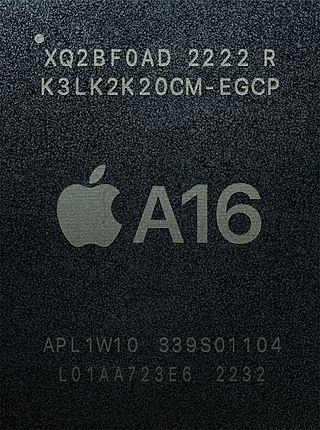
Apple silicon refers to a series of system on a chip (SoC) and system in a package (SiP) processors designed by Apple Inc., mainly using the ARM architecture. They are the basis of Mac, iPhone, iPad, Apple TV, Apple Watch, AirPods, AirTag, HomePod, and Apple Vision Pro devices.

The Apple M-series coprocessors are motion coprocessors used by Apple Inc. in their mobile devices. First released in 2013, their function is to collect sensor data from integrated accelerometers, gyroscopes and compasses and offload the collecting and processing of sensor data from the main central processing unit (CPU).
This is a comparison of ARM instruction set architecture application processor cores designed by ARM Holdings and 3rd parties. It does not include ARM Cortex-R, ARM Cortex-M, or legacy ARM cores.
The Apple A8 is a 64-bit ARM-based system on a chip (SoC) designed by Apple Inc., part of the Apple silicon series, It first appeared in the iPhone 6 and iPhone 6 Plus, which were introduced on September 9, 2014. Apple states that it has 25% more CPU performance and 50% more graphics performance while drawing only 50% of the power of its predecessor, the Apple A7. The latest software updates for the 1.1GHz and 1.4GHz variants systems using this chip are iOS 12.5.7, released on January 23, 2023 as they were discontinued with the release of iOS 13 in 2019, and 1.5 GHz variant for the iPad Mini 4 is iPadOS 15.8.2, released on March 5, 2024 as it was discontinued with the release of iPadOS 16 in 2022, while updates for the 1.5 GHz variant continue for Apple TV HD. The A8 chip was discontinued on October 18, 2022, following the discontinuation of the Apple TV HD.

The iPhone 7 and iPhone 7 Plus are smartphones that were developed and marketed by Apple Inc. They are the tenth generation of the iPhone. They were announced on September 7, 2016, at the Bill Graham Civic Auditorium in San Francisco by Apple CEO Tim Cook, and were released on September 16, 2016, succeeding the iPhone 6, iPhone 6 Plus, iPhone 6S and iPhone 6S Plus as the flagship devices in the iPhone series. Apple also released the iPhone 7 and iPhone 7 Plus in numerous countries worldwide throughout September and October 2016. They were succeeded as flagship devices by the iPhone 8 and iPhone 8 Plus on September 12, 2017, and were discontinued with the announcement of the iPhone 11 and iPhone 11 Pro on September 10, 2019.

The Apple A10 Fusion is a 64-bit ARM-based system on a chip (SoC) designed by Apple Inc., part of the Apple silicon series, and manufactured by TSMC. It first appeared in the iPhone 7 and 7 Plus which were introduced on September 7, 2016, and is used in the sixth generation iPad, seventh generation iPad, and seventh generation iPod Touch. The A10 is the first Apple-designed quad-core SoC, with two high-performance cores and two energy-efficient cores. Apple states that it has 40% greater CPU performance and 50% greater graphics performance compared to its predecessor, the Apple A9. The Apple T2 chip is based on the A10. On May 10, 2022, the iPod Touch 7th generation was discontinued, ending production of A10 Fusion chips. The latest software updates for the iPhone 7 & 7 Plus including the iPod Touch 7th generation variants systems using this chip are iOS 15.8.3, released on July 29, 2024, as they were discontinued with the release of iOS 16 in 2022, while updates for the iPad variants systems using this chip are still supported.

The iPhone 8 and iPhone 8 Plus are smartphones developed and marketed by Apple Inc. They are the eleventh generation of the iPhone. The iPhone 8 was released on September 22, 2017, succeeding the iPhone 7 and iPhone 7 Plus respectively.

The iPhone X is a smartphone that was developed and marketed by Apple Inc. It is part of the 11th generation of the iPhone. Available for pre-order from October 27, 2017, it was released on November 3, 2017. The naming of the iPhone X marked the 10th anniversary of the iPhone.

The iPhone XS and iPhone XS Max are smartphones developed and marketed by Apple Inc. They are the twelfth-generation flagships of the iPhone, succeeding the iPhone X. Apple CEO Tim Cook announced the devices alongside a lower-end model, the iPhone XR, on September 12, 2018, at the Steve Jobs Theater at Apple Park. Pre-orders began on September 14, 2018, and the devices went on sale on September 21. As of June 2024, the iPhone XS is the oldest iPhone model officially capable of running iOS 18, the latest version of iOS.

The iPhone XR is a smartphone developed and marketed by Apple Inc. It is part of the twelfth generation of the iPhone, alongside the higher-end iPhone XS/XS Max models. Pre-orders began on October 19, 2018, with the official release on October 26, 2018. The iPhone XR was the least expensive device in Apple's twelfth generation of iPhones, which also includes the iPhone XS and XS Max, and was therefore considered an "affordable flagship" or "budget flagship" phone at its release.

The Apple A12 Bionic is a 64-bit ARM-based system on a chip (SoC) designed by Apple Inc., part of the Apple silicon series, It first appeared in the iPhone XS and XS Max, iPhone XR, iPad Air, iPad Mini, 8th generation iPad and Apple TV 4K. Apple states that the two high-performance cores are 15% faster and 40% more energy-efficient than the Apple A11's, and the four high-efficiency cores use 50% less power than the A11's. It is the first mass-market system on a chip to be built using the 7 nm process.

The Apple A12X Bionic is a 64-bit system on a chip (SoC) designed by Apple Inc., part of the Apple silicon series, It first appeared in the iPad Pro, announced on October 30, 2018. The A12X is an 8-core variant of the A12 and Apple states that it has 35 percent faster single-core CPU performance and 90 percent faster overall CPU performance than its predecessor, the Apple A10X. The Apple A12Z Bionic is an updated version of the A12X, adding an additional GPU core, and was unveiled on March 18, 2020, as part of the iPad Pro.

The fifth-generation iPad Mini is a tablet computer in the iPad Mini line, developed and marketed by Apple Inc. Announced in a press release along with the third-generation iPad Air on March 18, 2019 and released the same day. Its predecessor, the iPad Mini 4, was discontinued on the same day.

The Apple A13 Bionic is a 64-bit ARM-based system on a chip (SoC), designed by Apple Inc., part of the Apple silicon series. It appears in the iPhone 11, 11 Pro/Pro Max, the 9th generation iPad, the iPhone SE and the Studio Display. Apple states that the two high performance cores are 20% faster with 30% lower power consumption than the Apple A12's, and the four high efficiency cores are 20% faster with 30% lower power consumption than the A12's.

The Apple A14 Bionic is a 64-bit ARMv8.4-A system on a chip (SoC)designed by Apple Inc., part of the Apple silicon series. It appears in the fourth generation iPad Air and tenth generation iPad, as well as iPhone 12 Mini, iPhone 12, iPhone 12 Pro, and iPhone 12 Pro Max. Apple states that the central processing unit (CPU) performs up to 40% faster than the A12, while the graphics processing unit (GPU) is up to 30% faster than the A12. It also includes a 16-core neural engine and new machine learning matrix accelerators that perform twice and ten times as fast, respectively.
Neural Engine is a series of AI accelerators designed for machine learning by Apple. The first SoC including Neural Engine is Apple A11 Bionic for iPhone 8, 8 Plus and iPhone X introduced in 2017. Since then, all Apple A series SoCs have Neural Engine. In 2020, Apple introduced the Apple M1 for Mac and all Apple M series SoCs have Neural Engine.

The Apple A15 Bionic is a 64-bit ARM-based system on a chip (SoC) designed by Apple Inc., part of the Apple silicon series. It is used in the iPhone 13 and 13 Mini, iPhone 13 Pro and 13 Pro Max, iPad Mini, iPhone SE, iPhone 14 and 14 Plus and Apple TV 4K.

The Apple A16 Bionic is a 64-bit ARM-based system on a chip (SoC) designed by Apple Inc., part of the Apple silicon series, and manufactured by TSMC. It is used in iPhones 14 Pro and 14 Pro Max, and 15 and 15 Plus.
The Apple A18 and Apple A18 Pro are a pair of 64-bit ARM-based system on a chip (SoC) designed by Apple Inc., part of the Apple silicon series. They are used in the iPhone 16 and iPhone 16 Pro lineups, and built on a second generation 3 nm process by TSMC. Announced on September 9, 2024, they are the successors to the Apple A16 Bionic and the Apple A17 Pro processors, respectively.















